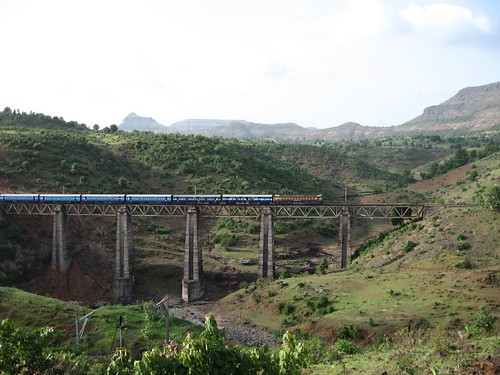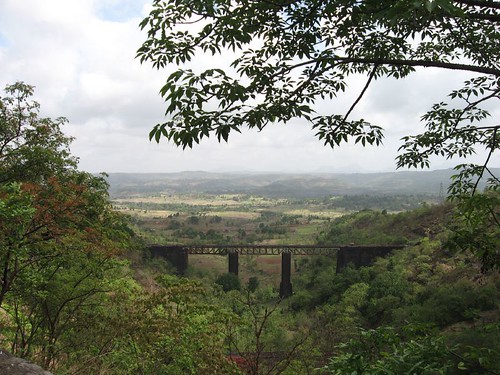Today the Konkan Railway, wends its fast and safe way through scenic country not despoilt by the pieces of engineering created for it. In fact Konkan Railway is an Indian triumph in many areas: engineering, efficiency, innovation, economy, speed, environmental awareness, public relations, aesthetics and service. A 760 kM rail path, laid on fairly flat rails over rivers and valleys and through mountains and gorges, it was designed and built by Indian engineers in a record time of eight years! It is a feat of civil engineering that the British had contemplated a century ago and abandoned as being too formidable.
The route is a single-line track, and is not electrified yet. It has been designed for high speed traffic (160 km/h). It is open to goods and passenger traffic. The route, which runs parallel to the Arabian Sea coastline, offers some of the most spectacular views of any Indian rail journey.The Konkan railway route intersects national highway NH-17 at many places. The NH-17 also runs between Mumbai and Mangaluru. KR does not have divisions like the other Indian Railways; however, it has two regions with headquarters at Ratnagiri in Maharashtra and Karwar in Karnataka.
 .
.
The Ratnagiri region extends from Roha to Sawantwadi, while the Karwar region extends from Pernem to Thokur (the latter being where Southern Railway begins, a few stations north of Mangalore). Surathkal can be considered as the southernmost station on Konkan railway as trains do not officially halt at Thokur.
For the first time in India funds for the project were raised without touching the government coffers. The authorised capital of Rs.800 crores was pooled together by the railways and the states of Kerala, Karnataka and Goa and Maharashtra. This was leveraged by means of public bonds to the extent of Rs.2250 crores. These bonds carried attractive rates of return, tax breaks and guaranteed repayment. The project also employed the least number of people in its management: at its peak a mere 2400, all in. From the beginning the Corporation had set its mind on extensive use of information technology. Consider this in conjunction with the fact that in 1990, IT had just about begun to make its presence felt worldwide. An international record in tunnel boring was set: the Natuvadi tunnel's 204 metres per month beat the previous 187 metres. In total there are 1798 bridges and 88 tunnels along the way
Until Konkan Railway started its operations, the two important port cities Mangalore and Mumbai were not directly connected by the railway network. Even though economic reasons provided a strong need to connect these two cities.

The region through which the railway track passed was geographically very tough and would be an engineering challenge.The ecology and scenic beauty of the region traversed by the Konkan Railway will make the journey along this route a pleasant and enjoyable experience for the passengers. The shortened time span and the easy accessibility to inland scenic spots or to beach fronts along the picturesque coastline should offer opportunities for travel not contemplated earlier and contribute to a booming tourist trade.
In an effort to make the region more accessible to tourists, important super fast trains like Delhi. Trivandrum Rajdhani Express have been diverted over the Konkan Railway. In addition, a Shatabdi Express has been also started between Mumbai. Madagaon. It was constituted as a separately incorporated railway, with its headquarters at CBD Belapur in Navi Mumbai and E. Sreedharan as its first Chairman and Managing Director. By May 1999, the Konkan Railway had laid a 760km broad gauge route from Roha to Mangalore along the western coast of India (the Konkan region).
 .
.
This project was substantially completed by October 1997 when Mr. Sreedharan was asked to take up the responsibility of construction of the Delhi Metro Project. Recently Mr E Sreedharan was called in Pakistan for development of Lahore Metro plan. Detection)system.
THE STORY OF HOW IT CAME UP
Mr. George Fernandes on his first day in office in 1989 as the Minister for Railways flagged off the Konkan Railway Corporation Ltd [KRCL]. Its mandate: raise your own funds and construct with speed and economy a railway connecting Mumbai with Mangalore and pay off the loans in the promised time. It was a sweeping challenge and it met its hero in Dr. E. Sreedharan, a veteran railway man known for brisk efficiency. Fernandes persuaded him out of his retirement and made him the Chairman and Managing Director of Konkan Railway.
A near flat track [-- a gradient of less than 1 foot in 150 feet] and a curvature of 1.25kM radius was to be maintained if the trains were to reach the target speeds of 160kM per hour. The problem was that the entire scenic Konkan coast is full of rivers, mountains, ravines, valleys and human settlements.

The only way the flat and fast track could be laid was by boring long and numerous tunnels through mountains, building tall viaducts through the valleys, creating high embankments, making deep cuts between peaks and building several bridges over water courses.Satellite images were used to decide on the alignment. When proving trips had to be undertaken into inhospitable terrain, the Corporation did away with the cumbersome government practice of ploughing through with jeeps.
Land acquisition was proceeding in the three states of Karnataka, Goa and Maharashtra. The approach was human and not official. The benefits of the railway to the region's economy was explained. They were reassured that their environment and ways of life would not be disturbed. Where they were to be displaced alternate spaces of their choice were to be provided. In Goa the bikies were at it again, fraternising with the local folks and explaining the project objectives. The Corporation acted fair. In many cases landowners had neglected the paper work. The Corporation did a lot of hand-holding and when the papers were set right, they were paid a fair price. A mango tree was valued between Rs.2,000 and Rs.10,000 jack-fruit trees, Rs.2000 and cashew trees, Rs.1000. Heritage , community and religious structures were left alone. Displaced farmers were helped with transportation and rehabilitation. Near Dasgaon a new burial ground was built and bones and remains from the old ground transported with reverence. Payment cheques were
door-delivered! All these were done in twelve months in a highly bureaucratised India!
The length of 760kM was divided into 7 sectors of approximately 100kM each. Each had a Chief Engineer with full freedom of decision making. And with the freedom came, in not so small a print, a definite time target.

Konkan Railway. Four concrete sleeper plants were set up at Chiplun, Madgaon, Kudal and Murdeshwar to manufacture the 1.3 million sleepers required for the project. Besides this cement, steel, explosives, rails and a hundred other things had to be delivered through harsh terrain. Depots were created for these. Wherever possible design was standardised to be built with pre-stressed parts cast elsewhere. International norms were followed in evaluating and short listing contractors. Their bids were decided upon within 72 hours of opening. Independent quality assurance inspectors were appointed.
For all these preparations the ordeal on the ground was not in any way mitigated. Many hair
raising adventures -- some that nearly killed them -- were encountered. In 1994 the Mahad sector had floods that stood 12 feet above road level! Four workers building the Byndoor tunnel were blown back 60 feet by a sudden gush of water. At Ukshi an entire mountainside buried the works and equipment.

